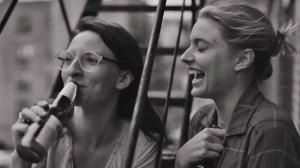The following paragraph is a variation of what Heidegger wrote in his Bremen Lectures. It’s one of 2 keys that helped me with understanding Terrence Malick’s lastest film, “To the Wonder.”
The Internet or Jet Age does not equal closeness. Almost everything is at our fingertips. Journeys that took months now take less than a day. News of major world events took years to make their way around the world, if they completed their journey at all. The Internet gives us major world events in seconds. Food out of season, I can have delivered to my table in the coldest and harshest winter in a day. I can see distant cities from long ago as if they were here today. The Internet and Jet Age which has reduced all distance, is the foundation of our commerce Yet, despite reducing all distances, no closeness seems to exist. There is even more loneliness and alienation.
The film starts off with a woman played by Olga Kurylenko saying in French, “I am newborn.” The trailers pretty much tip off that this newborn-ness is the sort you get when you fall in love and the entire world gets transfigured.
The audience is then given vignettes and montages of a couple exploring Paris and Le Mont St. Michel. The first 5 minutes are actually filmed with a digital harinezumi, a cheap Japanese digital camera that gives video a gritty, edgy feel through grain while saturating and washing out colors in unexpected ways.
The man in the couple, played by Ben Affleck, asks the woman and his daughter to come back with him to live in Oklahoma. The relationship unravels from there and never seems to have the intensity and vitality it had in France. While in Oklahoma we are presented with Malick’s trademark scenes involving fields of wheat shot during “magic hour,” the hours around sunrise and sunset when golden light casts everything better than it really is, or so it seems.
It’s not only for aesthetic reasons that Malick shoots during “magic hour.” There are sections of Being and Time where Heidegger finds the origins of our entanglement with the world in the sun:
Taking care makes use of the handiness of the sun giving forth light and warmth. The sun dates the time interpreted in taking care. From this dating arises the most natural measure of time, the day… Thrown being-together-with things at hand is grounded in temporality. (Being and Time, II.vi.413)
There is no division between humanity and nature. We are imbued with each other, intertwined, yet when Malick films “nature” he is trying to return us to something more primordial – time measured in the intensity of light, not in numbers.
If nature is sick, through our lack of taking care, then we, too, shall be sick. This is a theme that echoes lightly in the background of the film. The man in the couple has some work related to the environment. The machinery we see seems to be used for fracking to get oil. The townspeople all echo that either the dogs or the children have started to act strangely because of some environmental collapse. The water is polluted and tar seeps out of the cracks in concrete.
It’s around this time that we got introduced to a priest played by Javier Bardem. Wow, it’s tough being a priest. You try to take care of things but then at the same time feel so isolated. An elderly woman tells him that she will pray for him that he might find joy.
The woman from France eventually has to go back because her visa expires. It’s at this time that Affleck’s character meets up with a local woman from his youth and starts a relationship with her. This local woman played by Rachel McAdams does lots of the voice overs. Although the land is sick, and her ranch is struggling, there are the buffalo – lots of them.
At the end of the movie, I felt the part about the priest didn’t make sense for the longest time. I also wondered why the movie ended with the image it ended with.
Luckily I ran into a nurse who went to see To the Wonder with a bunch of philosophy grad students. She had a BBQ and there I met one of them that supplied the missing piece, Kierkegaard’s Works of Love.
In this work Kierkegaard talks about 2 sorts of love: the kind that blossoms and so must eventually die, and the love where we must care for everyone but never dies. Both are inevitable, and the inevitability of either kind of love is a theme in Malick’s movie. The couple has the first kind of blossoming love; whereas the priest has the second kind of love.
There are images that just stick with you, and I’ve often wondered why Malick doesn’t also do photography. Perhaps it’s because in a Heideggerian sense, photos are a covering up of temporality.
One of the images that just sticks with me is of the water flowing up slowly during high tide at Le Mont St. Michel. Another is of the fields of wheat with the sun. These alone would make strong photos.
Heidegger’s Bremen Lectures and Kierkegaard’s Works of Love seem to be a pre-requisite for this film. I really loved it even though I was missing the Kierkegaard piece.
